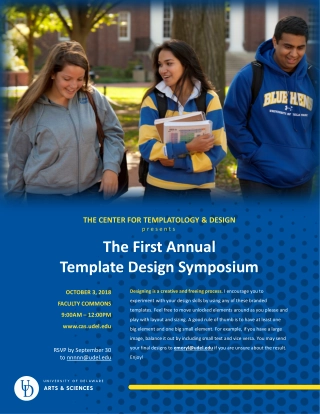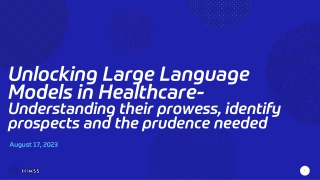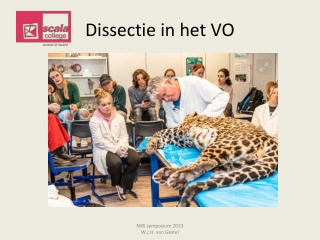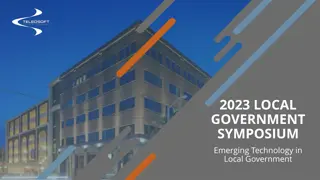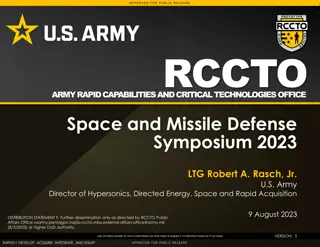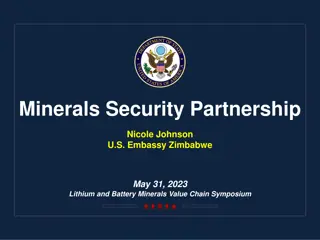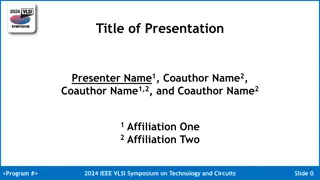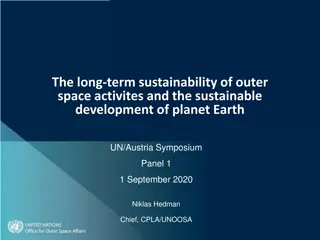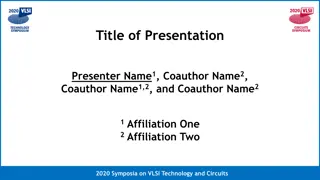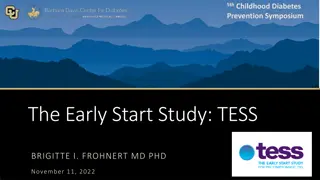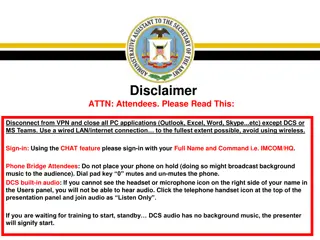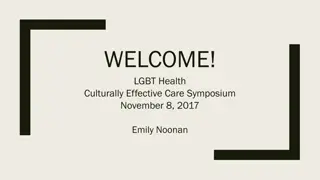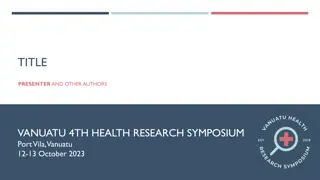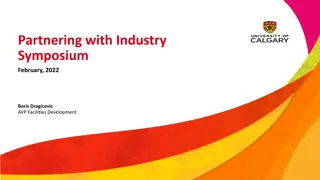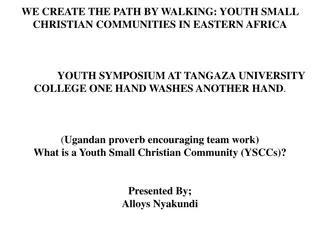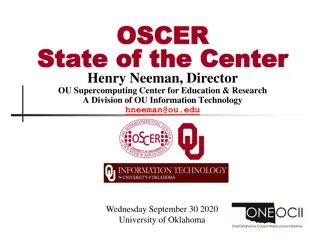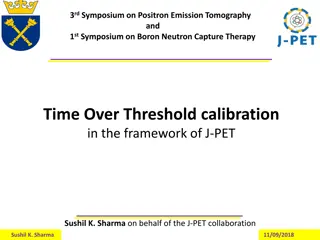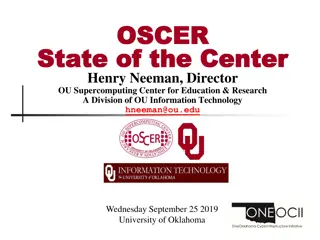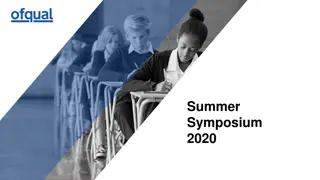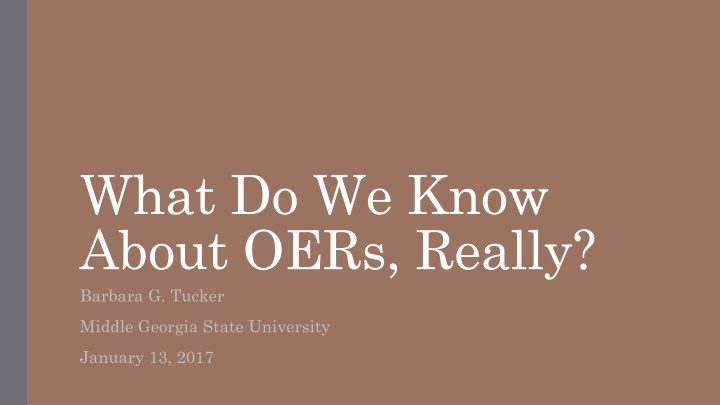
Insights on OERs Impact: Student and Faculty Perspectives
Discover the impact of Open Educational Resources (OERs) on student satisfaction, faculty satisfaction, and learning outcomes. Explore preferences for digital versus print textbooks, faculty views on knowledge creation, and satisfaction with open resources. Gain valuable insights into the benefits and challenges of OER adoption in education.
Download Presentation

Please find below an Image/Link to download the presentation.
The content on the website is provided AS IS for your information and personal use only. It may not be sold, licensed, or shared on other websites without obtaining consent from the author. If you encounter any issues during the download, it is possible that the publisher has removed the file from their server.
You are allowed to download the files provided on this website for personal or commercial use, subject to the condition that they are used lawfully. All files are the property of their respective owners.
The content on the website is provided AS IS for your information and personal use only. It may not be sold, licensed, or shared on other websites without obtaining consent from the author.
E N D
Presentation Transcript
What Do We Know About OERs, Really? Barbara G. Tucker Middle Georgia State University January 13, 2017
A lot in terms of How to do it Who is doing it Where it s being done The technologies The promises
Somewhat more, in terms of Student satisfaction Faculty satisfaction Achievement of learning outcomes
Student Satisfaction Strong evidence of student preference due to convenience and cost (Baek & Monaghan, 2013) as well as quality (Hilton et al, 2013). Etext not real preference of majority--yet (Woody, Daniel, & Baker, 2010; Weisberg, 2011; Nicholas & Lewis, 2011; Liu, 2005; Liu, 2011; Bolkan, 2015; Azevedo, 2013; Student characteristics (Ngafeeson & Sun, 2015; Experience factors, 2015) Developmental readers (Burgess, Price, & Caverly, 2012) Discipline (Ciampa, Thrasher, Marston, & Revels, 2013) However: cost and convenience outweigh preference for physical book Our data inconclusive
Which format of the textbook do you prefer? (325 answers) Electronic/digital 122 (37.5%) Print only 54 (16.6%) I like to have access to both 149 (45.8%) Format Preference Print Digital Prefer access to both
Faculty Satisfaction Dependent on view of knowledge creation, pedagogy, altruism, self, society The Open Courseware concept is based on the philosophical view of knowledge as a collective social product . . . . - V. S. Prasad, Vice- Chancellor - Dr. B. R. Ambedkar Open University, India (cited in Downes, 2007) One interesting thread coming from teacher open responses was a sense that teachers were aware that flaws in open textbooks could be readily fixed (Hilton et al, 2013).
Faculty Satisfaction Kansas State University study found (Delimont et al, 2016) significant satisfaction with open/alternative resources in terms of quality and student learning. Allen & Seaman, 2014. 2144 professors surveyed, only 34% were familiar with OER Of that 34%, vast majority of those rated them as equal to or superior to publishers texts.
Research on British users of OERs (Farrow et al., 2015) Educators (37.6%) and formal learners (55.7%) say that using OER improves student satisfaction. Educators (27.5%) and formal learners (31.9%) agree that OER use results in better test scores. OER users (79.4%) adapt resources to fit their needs. Educators (79.5%) use OER to get new ideas and inspiration. Learners (88.4%) say that the opportunity to study at no cost influenced their decision to use OER. (Not all learners were formal) Implementation of OER can improve student performance by increased access, but often indirectly through increased confidence, satisfaction, and enthusiasm for the subject.
Study at Athabasca Open University in Canada found what would influence faculty use of OERs (McKerlich et al, 2011) Factor Combined % Count Academic quality 87 78 Time to find, review, select 82 74 Knowledge about OER 78 70 Desire to reduce costs for students 74 67 Hardware /software to facilitate use 74 67 Environmental concerns 68 61
Reflection/Discussion Situations where students did not prefer? Indications of faculty satisfaction/understanding/involvement on your campus?
Achievement of Learning Outcomes This could be the weakest area of research so far, but improving. Studies limited so far as to the achievement of learning outcomes of OERs compared to traditional textbooks Fischer, Hilton, Robinson, & Wiley, 2015 most complete and rigorous Large sample size 16,727 at 4 colleges and 6 community colleges 15 different courses Looked at grades, course completion, and enrollment intensity in current and next semester Treatment group had better course completion and higher enrollment intensity in current and following semester Course completion and grades mixed, but OERs not worse.
Also Allen, Guzman-Alvarez, Smith, Gamage, Molinaro, & Larsen, (2015) Over 900 students, divided between control and treatment group Same instructor, consecutive class hours Chemistry using Chemistry Wiki (OER) and traditional book No significant difference on final exams AND Pilot study at Dalton State College OpenStax A & P I and II text No significant difference in learning outcomes Small sample
Extensive studies becoming more frequent Hilton et al, 2013 Scottsdale Community College Widespread adoption in six math classes 2,043 in 65 sections, 42 instructors Comparable and better success rates and retention rates except for lowest level of learning support math Affected by change in policy for lowest level Difference in lowest level may show consistency with the finding that learning support students struggle with etext.
Research Confounded by: In some studies the OERs are used only in online courses (Kramer, Neugebauer, Magenheim, & Huppertz, 2015) or MOOCs Studies of high school students rather than college students (of many ages)(Robinson, Fischer, Wiley, & Hilton, 2014) Better, more altruistic instructors and users of OERs self-selecting (McKerlich, Ives, & McGreal 2013) Research asks for student perceptions are they in a position to know? Control group using the traditional textbook not all students access the book Student perceptions could be biased by low/no-cost OERs are broadly defined and may not be textbooks per se but combinations of online resources Newness of them and different experience of reading etexts
Advantages of OER Adaptable Accessible No significant difference in learning outcomes yet found Digital resources can incorporate direct interactivity Beneficial for international/emerging economies Beneficial for growing community of learners and scholars and emotional ownership (Downes, 2007). OERs have the capability of meeting outcomes and local standards better (not always realized)
Disadvantages of OERs Have to find them, create, or adapt. Adoption and creation are two different activities (McKerlich, Ives, & McGreal, 2013) Have to understand open licensing and be sure licenses are correct/in place Have to be comfortable with technology or willing to learn Agreement with the whole department in multi-section courses May need updating and adaption, rather than just going by the standard textbook. Have to vet them yourself for quality NO ASSUMPTIONS Effort involved may not translate to personal outcomes desired
Outstanding Questions What is the purpose of a textbook? Is cost the main criterion for adoption of OER? What does free really mean? (social vs. cost) The whys of data not fully explored mitigating circumstances? Do those who use OERs have an ethical obligation to create OERs? (Stephenson, 2005, cited in Downes, 2007) Sustainability and the meaning of free (cost vs. usage vs. ?) Revisions of resources when, how?
THE DALTON STATE STORY Nine grants Two in biological sciences: use of OpenStax Anatomy and Physiology book and development of NCTS lab manual for Biology 1107 and 1108 Three in social sciences: use of OpenStax psychology textbook; use of OpenStax sociology textbook; use of two different open textbooks and resources for American Government Two in School of Education to collate open resources in two introductory education courses to replace textbook One in English: create/adapt open textbook for ENGL 0098 (QEP) One in communication: create a textbook to replace Lucas, The Art of Public Speaking
COMM 1110 Awarded Round 3, began July 2015 Plan: write book and create ancillaries Motivation Cost of text Too frequent new editions Dealing with publisher s rep Used part of an existing (but weak) public speaking text, which ended up constituting about of 320-page book (that writer did not want attribution!) Housed on our libguides, and here in Georgia View sections, and GA Knowledge Repository.
Good things: Data points Successful pilot in Summer 2016 Somewhat successful full implementation in Fall 2016 Help from Auxiliary Services Student Satisfaction Learning outcomes
If you used the digital version, how did you access it (check all the apply)? Desk computer 76 Laptop computer PC 152 Laptop computer MAC 68 IPad 29 Tablet of another brand 13 Cell phone 82
Comparison to other books (From Fall 2015 survey) I found the reading level of (the current publisher s textbook) to be ___ to read than other textbooks (254 responses) In comparison to my other textbooks, I find Exploring Public Speaking to be (298 answers) Harder to read 13 (4.4%) Harder to read 11 (4.3%) About the same to read 155 (52%) About right 145 (57.1%) Easier to read 130 (44%) Easier 98 (38.6%)
Comparison with other textbooks In comparison to my other textbooks, I find Exploring Public Speaking to be (286 answers) (From Fall 2015 survey) I found (the current publisher s textbook) to be _____ to read than other textbooks. (258 responses) Less interesting 46 (16%) Less Interesting 59 (22.9%) About the same level of interest 190 (66.4%) At the same level of interest 164 (63.6%) More interesting 50 (17.5%) More interesting 35 (13.6%)
Comparison with previous text (Fall 2015 Survey) I have read __ of the chapters/pages assigned in the textbook for this class. (252 responses) (Fall 2016 Survey) I have read approximately ___% of the chapters/pages assigned in the OER textbook for this class. 372 answering. 100% 28 (7.5%) 100% 27 (10.7%) 75% 146 (39%) 75% 77(30.5%) 50% 131 (35.2%) 50 52 (20.6%) 25% 57 (22.6%) 25% 55 (14.8%) 0% 39 (15.5%) 0% 12 (3.2%)
My instructor used the book Exploring Public Speaking 282 answers As the primary source of information for the class 119 (42%) As a complement added to the material given in lectures and PowerPoints 163 (58%)
Course Assessment Data Spring 2016 (publisher s book) Fall 2016 (OER) Traditional, main campus all four measures met Traditional, main campus all four measures met Traditional, off-campus site all four measures met Traditional, off-campus site all four measures met Hybrid - not taught Hybrid three of four measures met
Average GPAs in course Summer 2015 2.71 Fall 2015 2.84 Summer 2016 (pilot) 3.25 Fall 2016 (first semester of implementation) 2.66
Obstacles Co-writer, Kris Barton, passed away in May Fulfilling all the requirements was stressful Faculty involvement lukewarm Will need to be revised in summer Grades went down somewhat
Most frequent praise (over 100) Free Written by and about Dalton State College Examples Helped me be successful in course Ease of reading Outlines samples in back Organization of chapters Available in digital and print
Three most frequent criticisms Boring and hard to follow Lack of online materials Graphics/look
Challenges to Faculty Creation of OERs Why? Because what they want in currently existing OERs doesn t exist Because publisher s textbook cost is not balanced by quality Because publisher s textbook does not meet individualized needs of curriculum or students (e.g., too long) Because there is some external incentive supporting the desire to create their own OERs (and equaling the effort involved)
Challenges to Faculty Creation of OERs Why not? Time Lack of information, especially on licensing and repositories Lack of encouragement from supervisor or tenure/promotion system (not original research) Multiple section course and other faculty have no interest in using the text
Once past those: Decisions Starting from scratch or using previous created materials of one s own Deciding what open licensed to use, remix, or borrow; finding issues and vetting them (Judith & Bull, 2016; Belikov & Bodily, 2016). Writing information versus creating pedagogically sound text Selling idea to other faculty, engagement, agreement of chairs and deans
And . . . Localizing and contextualizing existing materials that are being remixed. Interactivity/formatting/design/accessibility/distribution are huge issues Revision How often? Format may allow constant revision theoretically, but would you want to do that, except to correct mistakes? How extensive? Links to external materials going dead could happen between revisions Engaging other stakeholders
Opportunities Faculty development, especially on the technology and the licensing Time allotted, if not money, for creation and updating. Further research into outcomes, not just what but why. Tying the use of OERs to quality improvement for accreditation purposes Encouragement of teams to avoid burnout and one faculty member s having sole responsibility.
Conclusion: What Ive learned OERs are a global phenomenon that will only grow There is more to them than providing low-cost materials; philosophical questions about knowledge construction, the goal of the university and education; postmodern views of higher education and the need for theoretical bases (Knox, 2013). Future questions may be sustainability cultural sensitivity quality control plateaued adoption (or growing expectation), addressing faculty barriers to creation and use (such as confusion of terminology and discoverability) (Belikov & Bodily, 2016).
References Azevedo, A. (2013, February 1). Pay nothing? Easier said than done. Chronicle of Higher Education, 59(21), A18-A19. Allen, G., Guzman-Alvarez, A., Smith, A., Gamage, A., Molinaro, M., & Larsen, D. S. (2015). Evaluating the effectiveness of the open-access ChemWiki resource as a replacement for traditional general chemistry textbooks. Chemistry Education Research And Practice, 16(4), 939. Allen, I.E. & Seaman, J. (2014). Opening the curriculum: Open educational resources in U.S. higher education. Pearson: Babson Survey Research Group. Baek, E., & Monaghan, J. (2013). Journey to textbook affordability: An investigation of students' use of eTextbooks at multiple campuses. International Review Of Research In Open And Distance Learning, 14(3), 1-26. Belikov, O. M. & Bodily, R. (2016). Incentives and barriers to OER adoption: A qualitative analysis of faculty perceptions. Open Praxis, 8Idoi:10.5944/openpraxis.8.3.308 Bliss, T. J., Robinson, T. J., Hilton, J., & Wiley, D. A. (2013). An OER COUP: College teacher and student perceptions of open educational resources. Journal Of Interactive Media In Education, 2013(1). DOI: http://doi.org/10.5334/2013-04
Bolkan, J. (2015, September 1). Survey: Most students prefer traditional texts over e-Books. Campus Technology.com. Retrieved from https://campustechnology.com/articles/2015/09/01/survey-most-students-prefer- traditional-texts-over-ebooks.aspx Burgess, M. L., Price, D. P., & Caverly, D. C. (2012, Fall). Digital literacies in multiuser virtual environments among college-level developmental readers. Journal of College Reading and Learning, 43(1), 13-30. Ciampa, M., Thrasher, E., Marston, S., & Revels, M. (2013). Is acceptance of E- textbooks discipline-dependent? Comparing business and non-business student perceptions. Research In Higher Education Journal, 20. Downes, S. (2007). Models for sustainable open educational resources.Interdisciplinary Journal of Knowledge and Learning Objects, 3, 29-44. Retrieved from ijello.org/Volume3/IJKLOv3p029-044Downes.pdf Clarke, V. (2015). Experience factors related to students perceptions of eTexts: extending the Technology Acceptance Model. Retrieved from https://dt.athabascau.ca/jspui/handle/10791/66 Farrow, R., Pitt, R., Arcos, B. l., Perryman, L., Weller, M., & McAndrew, P. (2015). Impact of OER use on teaching and learning: Data from OER Research Hub (2013-2014). British Journal Of Educational Technology, 46(5), 972-976. doi:10.1111/bjet.12310
Fischer, L., Hilton, J. I., Robinson, T. J., & Wiley, D. A. (2015). A multi- institutional study of the impact of open textbook adoption on the learning outcomes of post-secondary students. Journal Of Computing In Higher Education, 27(3), 159-172. Hilton, J. I., Gaudet, D., Clark, P., Robinson, J., & Wiley., D. (2013). The adoption of open educational resources by one community college math department. International Review Of Research In Open And Distance Learning, 14(4), 37-50. Hsu, L. S., Walsh, E., & Malhotra, R. (2014). What Technology Do Students Use: Implications for Faculty Development. Digital Commons@Georgia Southern. Judith, K.,& Bull, D. (2016 March). Assessing the potential for openness: A framework for examining course-level OER implementation in higher education. Education Policy Analysis Archives, 24(42), 1-19. Knox, J. (2013). Five critiques of the open educational resources movement. Teaching In Higher Education, 18(8), 821-832. Kr mer, B. J., Neugebauer, J., Magenheim, J., & Huppertz, H. (2015). New ways of learning: Comparing the effectiveness of interactive online media in distance education with the European textbook tradition. British Journal Of Educational Technology, 46(5), 965-971.
Liu, H. (2011). What do the college millennial learners say about an open source digital textbook for a teacher education course? Journal Of Technology Integration In The Classroom, 3(1), 17. Liu, Z. (2005). Reading behavior in the digital environment: Changes in reading behavior over the past ten years. Journal of Documentation, 61( 6), 700-712. McKerlich, R., Ives, C., & McGreal, R. (2013). Measuring use and creation of open educational resources in higher education. International Review Of Research In Open And Distance Learning, 14(4), 90-103. Ngafeeson, M. N. & Sun, J. (2015). The effects of technology innovativeness and system exposure on student acceptance of E- textbooks. Journal of Information Technology Education: Research, 14, 55-71. Retrieved from http://works.bepress.com/madison_ngafeeson/8/ Ngafeeson, M.N. Sun, J. (2015). "E-Book acceptance among undergraduate students: A look at the moderating role of technology innovativeness" International Journal of Web-Based Learning and Teaching Technologies, 10(3). Retrieved from http://works.bepress.com/madison_ngafeeson/9/ Nicholas, A. J., & Lewis, J. K. (2011). Is free really cost-effective? A case study of open access e-textbook usage in several undergraduate business courses. Proceedings Of The Northeast Business & Economics Association, 350-354.
Robinson, T. J., Fischer, L., Wiley, D., & Hilton, J. I. (2014). The impact of open textbooks on secondary science learning outcomes. Educational Researcher, 43(7), 341-351. Sutton, S.C. & Chadwell, F. A. (2014). Open textbooks at Oregon State University: A case study on new opportunities for academic libraries and university presses. Journal of Librarianship and Scholarly Communication, 2(4), 34-48. doi: 10.7710/2162-3309.1174 Weisberg, M. (2011). Student Attitudes and Behaviors Towards Digital Textbooks. Publishing Research Quarterly, 27(2), 188-196. doi:10.1007/s12109-011-9217-4 Woody, W. D., Daniel, D. B., Baker, C. A. (2010, November). E-books or textbooks: Students prefer textbooks. Computers and Education, 55(3), 945-948. doi:10.1016/j.compedu.2010.04.005

